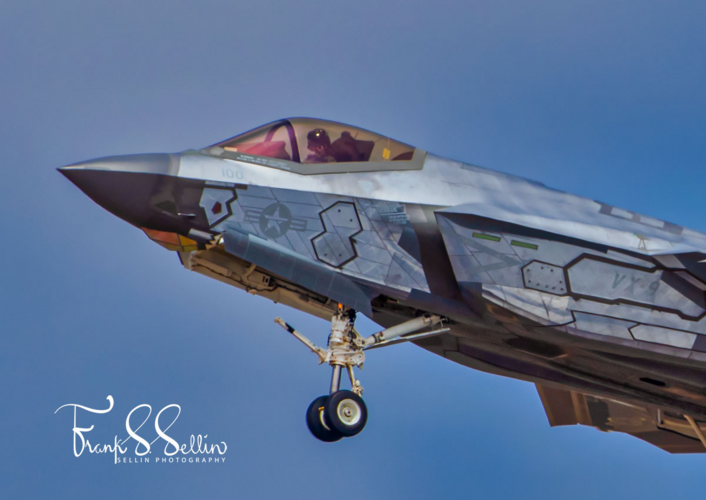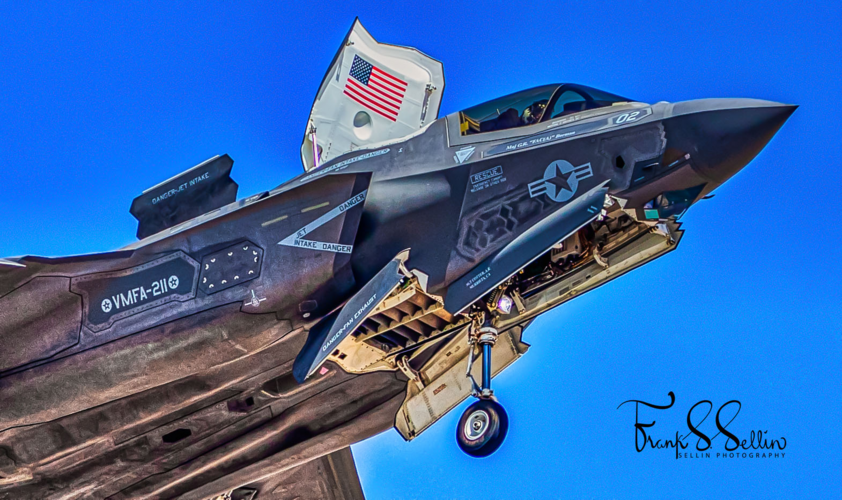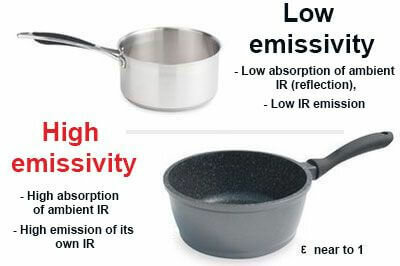Looks like some of the 'panels' might have come off too.
You are using an out of date browser. It may not display this or other websites correctly.
You should upgrade or use an alternative browser.
You should upgrade or use an alternative browser.
Lockheed Martin F-35 Lightning II Joint Strike Fighter (JSF)
- Thread starter Triton
- Start date
Forest Green
ACCESS: Above Top Secret
- Joined
- 11 June 2019
- Messages
- 9,496
- Reaction score
- 17,358
Dual purpose chaff.Looks like some of the 'panels' might have come off too.
siegecrossbow
I really should change my personal text
- Joined
- 12 March 2012
- Messages
- 707
- Reaction score
- 2,106
^ reminds me of the metallic coating/skins that were common in 50s era aircraft.. aside from the geometric shapes
Those weren’t metallic coating but clear coating that happened to expose the aluminum skin underneath.
jeffb
ACCESS: Top Secret
- Joined
- 7 October 2012
- Messages
- 1,280
- Reaction score
- 1,935
Peel and stick! Diamond shaped.
Edge alignment definitely seems to be a factor, doesn't it.
perttime
I really did change my personal text
- Joined
- 30 March 2013
- Messages
- 311
- Reaction score
- 318
Do the tiles reduce signature, or increase it?The tiles are interesting. A lot of them around the nose almost look like stickers, something applied to the skin of the plane.^ reminds me of the metallic coating/skins that were common in 50s era aircraft.. aside from the geometric shapes
Most of them appear to be the same size too.
I believe F-35 sometimes make their presence apparent, to hide their real capabilities.
jeffb
ACCESS: Top Secret
- Joined
- 7 October 2012
- Messages
- 1,280
- Reaction score
- 1,935
New pic (claimed August 2022). Coating looks similar to the one they were putting on the F-22.

View: https://twitter.com/SellinPhotogra1/status/1563925595746029569?s=20&t=vv0ghzpp3Y1HzJIT_A2xYg

View: https://twitter.com/SellinPhotogra1/status/1563925595746029569?s=20&t=vv0ghzpp3Y1HzJIT_A2xYg
jeffb
ACCESS: Top Secret
- Joined
- 7 October 2012
- Messages
- 1,280
- Reaction score
- 1,935
From April 2022. Apparently not a Marines thing

View: https://twitter.com/SellinPhotogra1/status/1522022704416976896?s=20&t=pZZ_ShWZtonx4v_8BdZfTw

View: https://twitter.com/SellinPhotogra1/status/1522022704416976896?s=20&t=pZZ_ShWZtonx4v_8BdZfTw
Last edited:
- Joined
- 6 August 2007
- Messages
- 3,894
- Reaction score
- 5,964
They reduce it. They’re testing how to apply it, how durable it is, etcDo the tiles reduce signature, or increase it?The tiles are interesting. A lot of them around the nose almost look like stickers, something applied to the skin of the plane.^ reminds me of the metallic coating/skins that were common in 50s era aircraft.. aside from the geometric shapes
Most of them appear to be the same size too.
I believe F-35 sometimes make their presence apparent, to hide their real capabilities.
Looking at how reflective the new coating is, they probably testing the new low emissivity coatingThey reduce it. They’re testing how to apply it, how durable it is, etcDo the tiles reduce signature, or increase it?The tiles are interesting. A lot of them around the nose almost look like stickers, something applied to the skin of the plane.^ reminds me of the metallic coating/skins that were common in 50s era aircraft.. aside from the geometric shapes
Most of them appear to be the same size too.
I believe F-35 sometimes make their presence apparent, to hide their real capabilities.

Maybe. I was wondering if they might just be a way of protecting the underlying radar absorbing coating.
This is my personal theory too. Radar absorbing paint is in principle simple, but has the problem that it needs to be soft, which is bad when it's applied to the forward surfaces of a supersonic aircraft. The successive generations of RAM is not about making them more radar-absorbent, it's about making them more durable. If someone has figured out a surface coating that's tought enough to handle supersonic winds, and transparent to radar, it would make stealth a lot easier.
If it also reflects IR well, which a metallic looking finish probably also does, well, that's a nice bonus.
Forest Green
ACCESS: Above Top Secret
- Joined
- 11 June 2019
- Messages
- 9,496
- Reaction score
- 17,358
I think it's about both durability and radar-absorption.
jeffb
ACCESS: Top Secret
- Joined
- 7 October 2012
- Messages
- 1,280
- Reaction score
- 1,935
If you look closely (under the VX-9) you can see the smaller diamond pattern underneath this chrome rectangular one suggesting they might be able to put them on in layers.New pic (claimed August 2022). Coating looks similar to the one they were putting on the F-22.
View attachment 683262
It's probably IR signature alteration. It might be that we should look at this as those bricks BAe demonstrated years ago on their ground vehicles.
The shiny silver finish is what brings the digital camo analogical (each bricks alter the IR signature of a specific spot and the lining just uniformizes the pattern).
Anyhow, I am surprised no one as yet brought the similarities with the Jocker's favorite outfit...

The shiny silver finish is what brings the digital camo analogical (each bricks alter the IR signature of a specific spot and the lining just uniformizes the pattern).
Anyhow, I am surprised no one as yet brought the similarities with the Jocker's favorite outfit...
Last edited:
I know one thing: it's going to be a bitch to model unless using massive decal sheets...
- Joined
- 28 January 2008
- Messages
- 1,016
- Reaction score
- 2,200
Non-stick finish as well, but wait!I know one thing: it's going to be a bitch to model unless using massive decal sheets...
- Joined
- 16 April 2008
- Messages
- 9,604
- Reaction score
- 14,490
I know one thing: it's going to be a bitch to model unless using massive decal sheets...
Laser cut frisket masks.
indicisivedivide
ACCESS: Confidential
- Joined
- 23 August 2022
- Messages
- 95
- Reaction score
- 126
Most detailed report of the engine that I could find.
siegecrossbow
I really should change my personal text
- Joined
- 12 March 2012
- Messages
- 707
- Reaction score
- 2,106
Do the tiles reduce signature, or increase it?The tiles are interesting. A lot of them around the nose almost look like stickers, something applied to the skin of the plane.^ reminds me of the metallic coating/skins that were common in 50s era aircraft.. aside from the geometric shapes
Most of them appear to be the same size too.
I believe F-35 sometimes make their presence apparent, to hide their real capabilities.
My guess is that for RCS reduction it is better or same but vastly superior IR reduction.
,
Last edited:
- Joined
- 9 October 2009
- Messages
- 21,953
- Reaction score
- 13,594
Or are meant to anyway.
Forest Green
ACCESS: Above Top Secret
- Joined
- 11 June 2019
- Messages
- 9,496
- Reaction score
- 17,358
Maybe the idea is that you wait until December and peal off one square each day in the lead up to Christmas and then an NGAD appears.
siegecrossbow
I really should change my personal text
- Joined
- 12 March 2012
- Messages
- 707
- Reaction score
- 2,106
Maybe the idea is that you wait until December and peal off one square each day in the lead up to Christmas and then an NGAD appears.
So, an ADVENT calendar.
Adaptive Versatile Engine Technology - Wikipedia
aonestudio
I really should change my personal text
- Joined
- 11 March 2018
- Messages
- 2,964
- Reaction score
- 7,492

Lockheed Martin Says Its F-35 Sustainment Costs Have Fallen by Half—Another 35 Percent Coming | Air & Space Forces Magazine
Lockheed Martin's portion of the F-35 cost per flying hour has fallen 50 percent in seven years and should go down another 35 percent.
Extracted from the link above:
Company charts said that in 2021 Air Force deployments, the F-35 achieved an 80 percent full mission capable rate. In the same year, foreign military sales operators of the jet recorded a 90 percent mission capable rate and a 65 percent full mission capable rate. “Full mission capable” means the jet can perform any of its various missions, while mission capable means it is ready to perform at least some of them, as opposed to being down for maintenance. In the most recent Red Flag exercise, out of 250 planned F-35 sorties, none were lost due to maintenance issues, the company reported.
“More than 90 percent of our parts are performing better than expected,” Aylward said.
For operating cost comparisons, Aylward also said the services should assess the reliability of fifth-generation aircraft—the F-22 and F-35—in an “apples to apples” way with fourth-generation airplanes. Whereas fourth-generation aircraft typically are assessed for operating cost without external podded capabilities such as electronic warfare, electro-optical systems, mission planning, and targeting, those features are built into fifth-generation aircraft. Assessing fourth-generation types with all those needed externals included would give a fairer comparison and one that would show that the F-35 is a solid performer, he said.
Maybe the idea is that you wait until December and peal off one square each day in the lead up to Christmas and then an NGAD appears.
Or chocolate.
- Joined
- 9 October 2009
- Messages
- 21,953
- Reaction score
- 13,594
Given previous such claims, I am more than a bit skeptical.
Lockheed Martin Says Its F-35 Sustainment Costs Have Fallen by Half—Another 35 Percent Coming | Air & Space Forces Magazine
Lockheed Martin's portion of the F-35 cost per flying hour has fallen 50 percent in seven years and should go down another 35 percent.www.airforcemag.com
aonestudio
I really should change my personal text
- Joined
- 11 March 2018
- Messages
- 2,964
- Reaction score
- 7,492
aonestudio
I really should change my personal text
- Joined
- 11 March 2018
- Messages
- 2,964
- Reaction score
- 7,492
I just noted there was some RAF Typhoon involved in the exercise, also. But why didn't they flew from England together with German's ones?! Were they already stationed in the region before?More images of Ex Pitch Black 22, including of the RAAF and USMC F-35s, may be found here.

Italian Air Force F-35 fleet hits 10000 flight hours
Italian Air Force F-35 fleet hits 10000 flight hours
No idea but I did find these:I just noted there was some RAF Typhoon involved in the exercise, also. But why didn't they flew from England together with German's ones?! Were they already stationed in the region before?More images of Ex Pitch Black 22, including of the RAAF and USMC F-35s, may be found here.

RAF’s Typhoons and Voyager participate in Pitch Black 22 for first time
The UK Royal Air Force’s (RAF) Typhoons and a Voyager tanker aircraft are participating in the multinational exercise Pitch Black 2022 for the first time.

British jets in massive Australian combat exercise
Britain has tested its ability to "deploy air power at speed to any part of the world".
 ukdefencejournal.org.uk
ukdefencejournal.org.uk
kaiserd
I really should change my personal text
- Joined
- 25 October 2013
- Messages
- 1,657
- Reaction score
- 1,726
Meant for another topic? (Uk F-35s not part of the deployment, unless I’m mistaken F-35s not even mentioned?)No idea but I did find these:I just noted there was some RAF Typhoon involved in the exercise, also. But why didn't they flew from England together with German's ones?! Were they already stationed in the region before?More images of Ex Pitch Black 22, including of the RAAF and USMC F-35s, may be found here.

RAF’s Typhoons and Voyager participate in Pitch Black 22 for first time
The UK Royal Air Force’s (RAF) Typhoons and a Voyager tanker aircraft are participating in the multinational exercise Pitch Black 2022 for the first time.www.airforce-technology.com

British jets in massive Australian combat exercise
Britain has tested its ability to "deploy air power at speed to any part of the world".ukdefencejournal.org.uk
Similar threads
-
Lockheed Martin F-16 Fighting Falcon Developments
- Started by seruriermarshal
- Replies: 630
-
-
-
RCAF Airbus CC-150 Polaris Replacement Program
- Started by Jason Dykstra (Wyvern)
- Replies: 52
-
